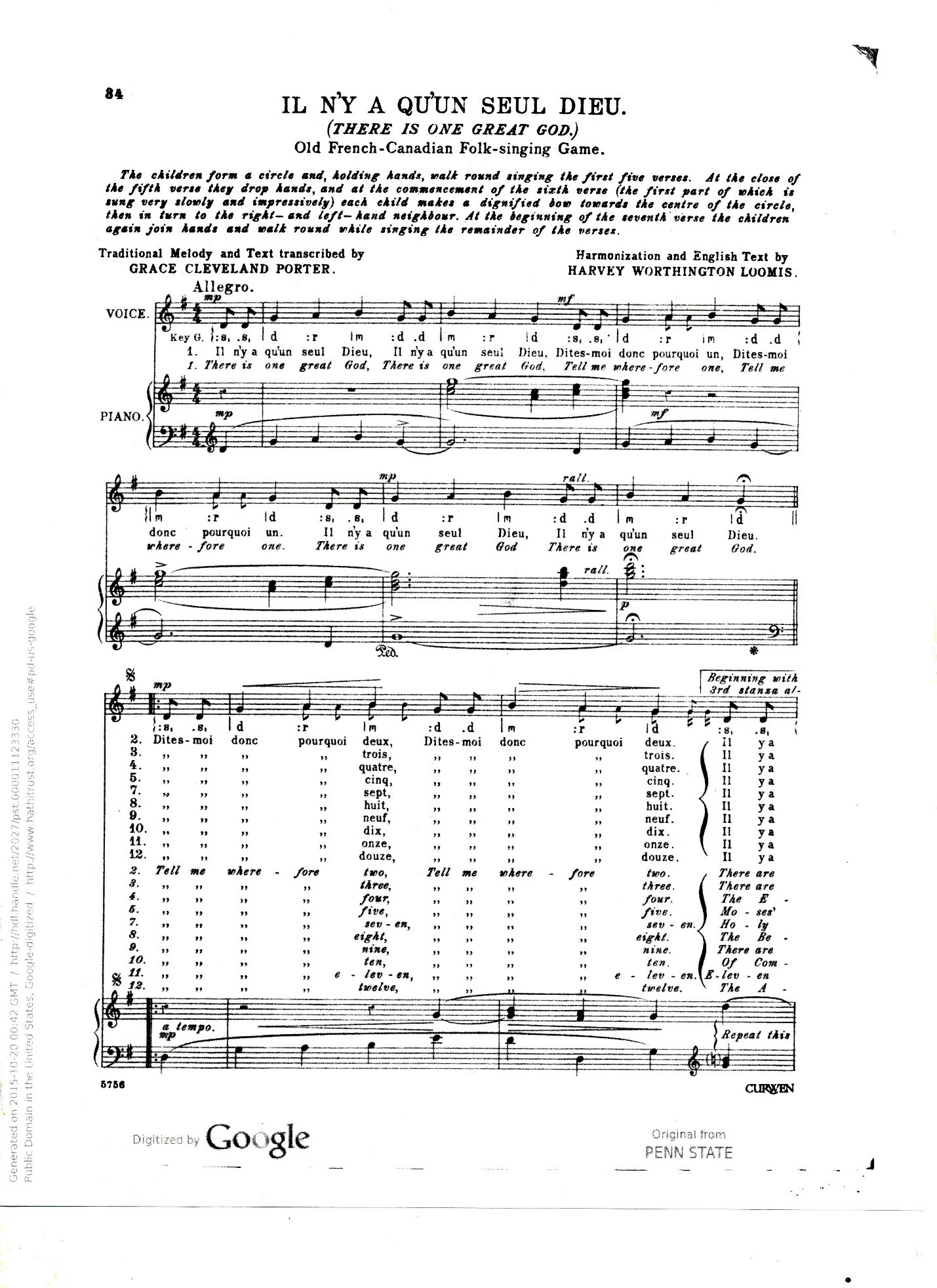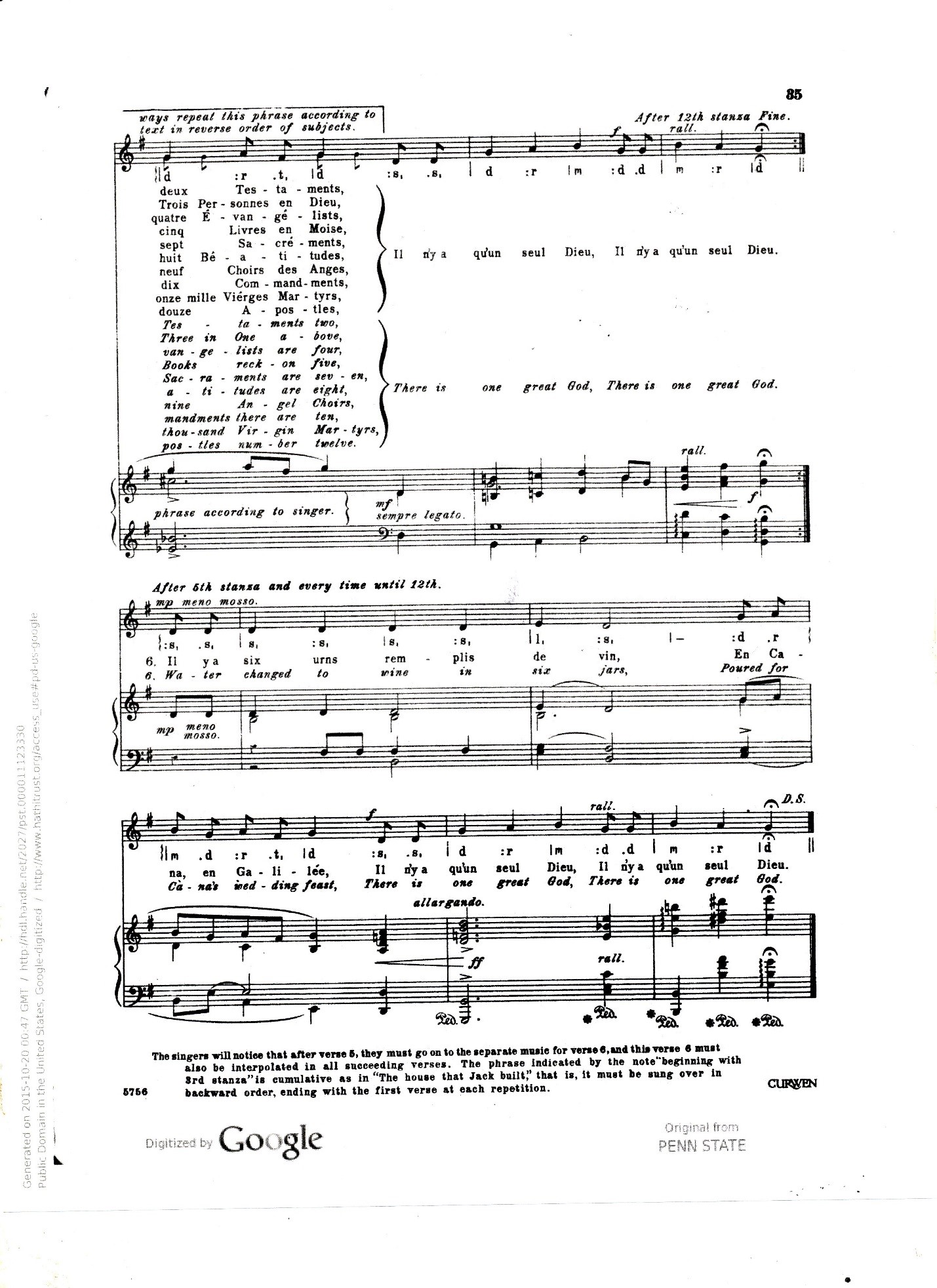Selections:
Video “Dis-moi pourquoi, une?” (“Tell Me Why, One?”)
Recorded: October 13, 1938, Baraga, Michigan
Performers: Mose and Exilia Bellaire
**Teacher Note: This song, also known by the title “Il n’y a qu’un seul Dieu” (“There Is One Great God”), is an old cumulative song traditionally sung and danced by children in a ring. Versions of it were sung in French and English throughout North America, including the version sung here by the Bellaires. The words deal with Christian themes. The song was adapted to Christianity from a Jewish ritual song “Echad mi yodea?” (“Who Knows the One?). The lesson includes ideas for using this resource in classrooms where Christian themes are not appropriate. The focus of the lesson is children’s cumulative songs and generational learning.
Activity 1: Exploring the Video
- Teacher explains that students will see a color movie filmed in 1938 in Baraga, Michigan, a community made up of many immigrants from Quebec, the French-speaking province of Canada. Alan Lomax shot the film footage and recorded audio separately, which is why the words and actions aren’t synched. (The footage could even be of a different song by the Bellaires.) This clip comes from Alan Lomax Goes North, ”The Most Fertile Source,” a documentary film edited by James P. Leary and Guha Shankar using Alan Lomax’s 1938 silent color film footage. The complete film is included in James P. Leary, Folksongs of Another America, Field Recordings from the Upper Midwest, 1937-1946 (University of Wisconsin Press and Dust to Digital, 2015).
- Students watch the video, paying particular attention to the people in the video and the landscape and buildings in the background.
Q—What do you see in the background of the video? (barn, fence, haystack, logs, porch)
Q—What do you think the Bellaires have done for a living? (farmer)
Q—How many people do you see?
Q—What would you guess are their ages?
Q—What are the two children doing? (The girl appears to be listening to the song. The boy begins to dance a jig, a tradition among French Canadians.)
Activity 2: “Dis-moi pourquoi, une?” (“Tell Me Why, One?”) A French-Canadian Children’s Song
- Students watch the video again, paying attention to the text and the organization of the song.
Q—How is the song organized? (question and answer, repetition) - Students perform the song. **Note that the video is a shortened version with six verses. The text below has all twelve verses written out in French and English, as sung by the Bellaires in the audio version of the song. The transcription comes from a slightly different version, with piano accompaniment, printed in Grace Cleveland Porter’s Negro Folk Singing-Games and Folk Games of the Habitants (1914).
Here are some performance suggestions:- French language (or other) classes may use the song in its entirety in French, divided into two groups for the question and answer parts of the song. The transcript of the text provided below may be used as needed. Cumulative songs such as this one have traditionally been used to teach other languages.
- Students learn/practice counting to six or twelve in French, singing Exilia’s part and then chanting down the numbers only of Mose’s part, while a) listening to the recording or b) teacher sings Mose’s complete verse. **In settings where the religious content of the text may be problematic, this approach may be useful.
- Students sing the song in the English translation.
- Students learn the sixth verse from Grace Cleveland Porter’s collection (see below) and sing/do the movements to the circle game as described at the beginning of the transcription.
Activity 3: Cumulative Songs
- Teacher draws attention to the special kind of repetition found in the song, and explains that songs like this are called “cumulative songs;” there is a progressive addition to each verse, so the song gets longer and longer. Many children’s songs are cumulative songs, which help learning through developing memory and teaching foreign languages.
- Students brainstorm and then sing cumulative songs that they know. Some common examples include:
- "The Twelve Days of Christmas"
- "Alouette"
- "The Green Grass Grew All Around"
- "Old McDonald Had a Farm"
- "There Was an Old Lady Who Swallowed a Fly"
- Students write their own words to the song “Dis-moi pourquoi, une?” (“Tell Me Why, One?”), using objects/places/people in their classroom, school, community, etc. as the subject. The chorus might be “That’s in our classroom, that’s in our classroom” or “Found in our home town, found in our home town.” Students perform their version for parents, other students, or members of the community.
“Dis-moi pourquoi, une?” (“Tell Me Why, One?”) as sung by Mose and Exilia Bellaire
Exilia: Di-moi pourquoi une
Di-moi pourquoi uneTell me why one
Tell me why oneMose: Il n’y a qu’un seul Dieu
Il n’y a qu’un seul DieuThere is but one God
Tell me why twoExilia: Di-moi pourquoi deux
Di-moi pourquoi deuxTell me why two
Tell me why twoMose: Deux testaments
Il n’y a qu’un seul Dieu
Il n’y a qu’un seul DieuTwo testaments
There is but one God
There is but one GodExilia: Di-moi pourquoi trois
Di-moi pourquoi troisTell me why three
Tell me why threeMose: Les trois Hébreux
Deux testaments
Il n’y a qu’un seul Dieu
Il n’y a qu’un seul DieuThree Hebrews
Two testaments
There is but one God
There is but one GodExilia: Di-moi pourquoi quatre
Di-moi pourquoi quatreTell me why four
Tell me why fourMose: Quatre évangélistes Four evangelists….. Exilia: Di-moi pourquoi cinq
Di-moi pourquoi cinqTell me why five
Tell me why fiveMose: Cinq livres de Moise Five books of Moses…. Exilia: Di-moi pourquoi six
Di-moi pourquoi sixTell me why six
Tell me why sixMose: Six urnes rendu
Aux Noces de CanaSix urns arrived
At the Marriage at Cana…..(**end of video clip; additional verse below on audio only) Exilia: Di-moi pourquoi sept
Di-moi pourquoi septTell me why seven
Tell me why sevenMose: Sept sacrements Seven sacraments…. Exilia: Di-moi pourquoi huit
Di-moi pourquoi huitTell me why eight
Tell me why eightMose: Huit Béatitudes Eight Beatitudes…. Exilia: Di-moi pourquoi neuf
Di-moi pourquoi neufTell me why nine
Tell me why nineMose: Neuf Choirs de Anges Nine angel choirs…. Exilia: Di-moi pourquoi dix
Di-moi pourquoi dixTell me why ten
Tell me why tenMose: Dix commandments Ten commandments..... Exilia: Di-moi pourquoi onze
Di-moi pourquoi onzeTell me why eleven
Tell me why elevenMose: Onze milles Viérges Martyrs Eleven thousand virgin martyrs…. Exilia: Di-moi pourquoi douze
Di-moi pourquoi douzeTell me why twelve
Tell me why twelveMose: Douze Apostles
Onze milles Viérges Martyrs
Dix commandments
Neuf Choirs de Anges
Huit Béatitudes
Sept sacrements
Six urnes rendu. placé
Aux Noces de Cana
Cinq livres de Moise
Quatre évangélistes
Les trois Hébreux
Deux testaments
Il n’y a qu’un seul Dieu
Il n’y a qu’un seul DieuApostles number twelve
Eleven thousand virgin martyrs
Ten commandments
Nine angel choirs
Eight Beatitudes
Seven sacraments
Six urns arrived
At the Marriage at Cana
Five books of Moses
Four evangelists
Three Hebrews
Two testaments
There is but one God
There is but one GodTranscription of Variant of “Dis-Moi Pourquoi Une?”
From Grace Cleveland Porter’s Negro Folk Singing-Games and Folk Games of the Habitants(1914). **Note the following differs from the Bellaires’ in verses 3, 6 and the tune itself. Both tunes are related, simple and easy to learn, and the accompaniment below should work with either.

Activity 4: Generational Learning
- Students recall or view the video again, paying attention to the Bellaires, the two children, and their ages.
Q—Do you think the children knew how to sing the song, too? How might they have learned it? (from the Bellaires [who may be their grandparents?] or from other children) - Teacher leads a discussion on music learning and who we learn songs from. Using the video as a point of departure, focus on the songs of different generations or age groups.
- Although there is often some overlap, different age groups often share and sing different music.
- Parents or grandparents may teach songs they learned as children (lullabies, nursery rhymes, game songs, etc.) to their own children or grandchildren.
- Music is transmitted within and between these different age-related groups.
- Songs are often learned/taught by oral transmission (listening, imitation, and example)
- Students complete one or both of the Music Learning Surveys (see below), focusing on a song learned from an elder, and/or a song learned from other students/friends their own age. **Focus on songs learned directly from another person (rather than from recordings, radio, Internet). Who taught you the songs you know? Other students? Teachers? Grandparents? Parents?
- Students share their answers with the class or in groups.
Credits:
Background information and translations of “Dis-moi pourquoi, une?” drawn from James P. Leary, Folksongs of Another America, Field Recordings from the Upper Midwest, 1937-1946 (University of Wisconsin Press, Dust to Digital, 2015).
Film footage excerpted from Alan Lomax Goes North, ”The Most Fertile Source,” a documentary film edited by James P. Leary and Guha Shankar using Alan Lomax’s 1938 silent color film footage. The complete film is included in Folksongs of Another America.
For more on the Generational Learning lesson (and other great ideas) see Louisiana Voices Unit VI Louisiana's Musical Landscape {Lesson 3 Generational Music Communities] http://www.louisianavoices.org/
Grace Cleveland Porter’s classic Negro Folk Singing-Games and Folk Games of the Habitants(1914) is in the public domain and available online.
Lesson Plan by Laurie Kay Sommers
With generous support from the NEA
